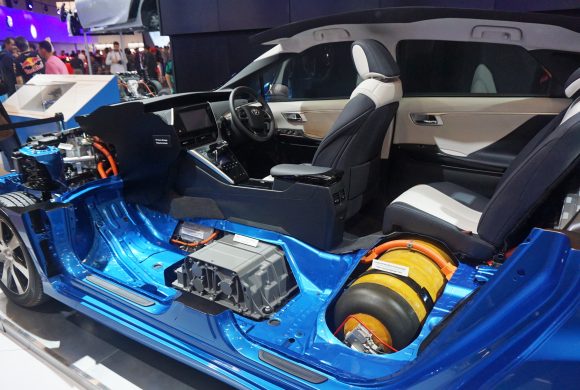Mycobacterium smegmatis is a bacterium that can generate electricity from hydrogen in the air through a unique enzyme called Huc. The discovery of this process has the potential to revolutionize the way we generate electricity, offering a new, clean source of energy that is both sustainable and eco-friendly.
The Huc enzyme has the remarkable ability to take up hydrogen from the air and convert it into electrical energy. This process is highly efficient, making it an attractive option for the development of new, sustainable energy sources.
The ability of Mycobacterium smegmatis to generate electricity from hydrogen in the air has significant implications for the development of clean energy technologies. It offers a new, highly efficient way to generate electricity that does not rely on fossil fuels or emit harmful pollutants.
Want to know more about this enzyme? Follow through.
The Huc Enzyme

According to the article in Nature, Huc is a newly discovered enzyme that is able to produce electrical energy by using hydrogen gas from the environment. The enzyme is produced by Mycobacterium smegmatis, a bacterium that is commonly found in soil and water.
The researchers who discovered Huc were able to isolate the gene that encodes for the enzyme and inserted it into other bacteria, which allowed them to study its properties in more detail. They found that the enzyme is able to transfer electrons from hydrogen gas to other molecules, producing electrical energy in the process.
The researchers also found that Huc is different from other hydrogenase enzymes, which are typically found in bacteria that live in extreme environments such as hot springs and deep-sea vents. Huc is able to function in a wider range of conditions and is more stable than other hydrogenase enzymes.
The discovery of Huc and its ability to produce electrical energy from hydrogen gas has significant implications for the development of sustainable energy sources. It offers a new, eco-friendly way to generate electricity that does not rely on fossil fuels or emit harmful pollutants.
An Enzyme Full of Potentials

One of the main advantages of Huc enzymes is that they can operate in any weather conditions, unlike other forms of renewable energy such as wind or solar. This means that they could potentially provide a more reliable source of energy.
Furthermore, the process of generating electricity with Huc enzymes is carbon-neutral, which means that it does not produce any greenhouse gas emissions. In addition to their ability to convert hydrogen gas into electricity, Huc enzymes may even potentially generate electricity from the air we are breathing in.
“Huc is extraordinarily efficient,” notes co-author Dr. Rhys Grinter. “Unlike all other known enzymes and chemical catalysts, it even consumes hydrogen below atmospheric levels—as little as 0.00005% of the air we breathe.” Overall, the potential of Huc enzymes in energy generation is significant.
Their ability to efficiently convert hydrogen gas and potentially air into electrical energy, along with their carbon-neutral process, make them a promising source of clean energy for the future. Further research and development are needed to fully realize their potential and bring this technology to market.
Why Hydrogen is the Dream Fuel

If we could efficiently convert hydrogen in the air into electricity, it could have significant implications for the energy industry and the environment. Hydrogen is a clean-burning fuel that produces water vapor as its only emission, making it a promising alternative to fossil fuels.
However, the concentration of hydrogen in the air is too low to extract and convert it into electricity efficiently. Even if we could extract hydrogen from the air, the energy required to do so would likely outweigh the energy produced, making it an inefficient process.
Instead, hydrogen can be produced from other sources, such as water or renewable sources like solar or wind energy. This hydrogen can then be used to generate electricity through fuel cells, which can power a variety of applications, including vehicles and buildings.
Additionally, the use of hydrogen as a fuel could significantly reduce greenhouse gas emissions and air pollution compared to traditional fossil fuels.
The researchers found that the enzyme was incredibly stable, which means it can work efficiently for long periods without degrading or losing its functionality. This is an important characteristic for an enzyme that could be used in a large-scale energy production process.
For the Future?

The bacterium producing Huc is also abundant in soil and water, which means it could be cultivated in large quantities to produce the Huc enzyme. This would make the enzyme accessible and cost-effective to produce for industrial applications.
If this new enzyme can be harnessed for large-scale energy production, it could provide a clean and sustainable alternative to fossil fuels. The stable nature of the enzyme and the potential for large-scale production of the bacteria could make this technology a game-changer for the energy industry.
However, further research is needed to understand the enzyme’s efficiency and scalability before it can be considered as a practical energy source. In addition to its potential as a source of clean energy, the use of Mycobacterium smegmatis and Huc enzyme in electricity generation could also have important applications in the field of biotechnology.
For example, it could be used to power implantable medical devices, such as pacemakers, without the need for batteries. While the use of Mycobacterium smegmatis and Huc enzyme in electricity generation is still in the early stages of research, it holds great promise for the future of sustainable energy.
As scientists continue to explore the potential of this process, it could help to reduce our dependence on fossil fuels and promote a cleaner, more sustainable future for all.



Leave a Reply